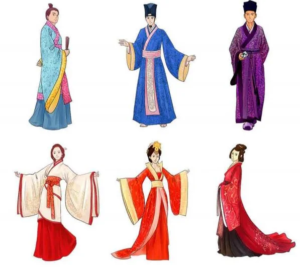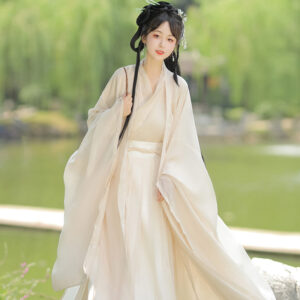

Hanfu, the traditional clothing of the Han Chinese, is intertwined with various legends and stories that highlight its cultural significance and historical roots. Here are some of the most notable tales associated with Hanfu:
1. The Origin of Hanfu
- Leizu and the Discovery of Silk: One of the most famous legends involves Leizu, the consort of the Yellow Emperor, who is credited with discovering silk. According to the story, while resting under a mulberry tree, a silkworm cocoon fell into her tea. Intrigued, she unraveled it and discovered silk threads, leading to the development of sericulture and silk weaving. This moment not only marks the birth of a fabric but also symbolizes cultural advancement in ancient China.
2. The Tale of Hua Mulan
- A Story of Bravery and Sacrifice: Hua Mulan is a legendary figure known for disguising herself as a man to take her elderly father’s place in the army. In various adaptations, Mulan wears her Hanfu beneath her armor, representing her dual identity as a dutiful daughter and a fierce warrior. Her story emphasizes themes of filial piety and courage, with Hanfu symbolizing her cultural roots and familial ties.
3. The Legend of Yue Fei
- Patriotism and Honor: Yue Fei, a celebrated general during the Song Dynasty, is often depicted wearing Hanfu as he fights against invaders. His commitment to his country and moral integrity are symbolized by the layering of his military armor over his Hanfu. This imagery reflects not only his martial prowess but also his deep connection to Chinese culture and values.
4. Wang Zhaojun and Hanfu Diplomacy
- Cultural Exchange through Marriage: Wang Zhaojun was known for her beauty and diplomatic skills during the Western Han Dynasty. Her marriage to the Xiongnu chieftain was part of a peace treaty between cultures. Clad in exquisite Hanfu during her journey to the Xiongnu territory, she represented the sophistication and cultural richness of Han society. Her story illustrates how clothing can serve as a diplomatic tool in fostering relationships between different cultures.
5. The Legend of the Eight Immortals
- Cultural Symbolism: The Eight Immortals are famous figures in Chinese mythology who embody various virtues and powers. In many depictions, they are shown wearing traditional clothing similar to Hanfu, which represents their connection to Chinese culture and values. Each immortal’s attire often reflects their personality traits or stories, reinforcing the idea that clothing can convey deeper meanings.
6. The Story of Liu Bei’s Three Visits
- Cultural Heritage in Warfare: In this tale from the Three Kingdoms period, Liu Bei visits Zhuge Liang three times to seek his counsel before forming an alliance against their enemies. The story emphasizes loyalty, wisdom, and strategy. While not directly about Hanfu, it highlights how traditional attire was worn by leaders during significant historical events, symbolizing their authority and cultural identity.
7. The Legend of Zhuangzi’s Dream
- Philosophical Reflections: Zhuangzi’s dream about being a butterfly is a philosophical tale that explores identity and transformation. In some interpretations, Zhuangzi is depicted wearing Hanfu, emphasizing how traditional clothing can represent one’s cultural identity while navigating life’s complexities.
8. The Tale of Lady Dai (Xin Zhui)
- Historical Significance: Lady Dai, from the Han Dynasty, is known for her well-preserved tomb artifacts that include beautiful silk garments resembling Hanfu. Her story reflects not only personal elegance but also the importance of clothing in representing social status during ancient times.
9. The Legend of Confucius
- Cultural Values: Confucius is often depicted wearing traditional attire that resembles Hanfu in art and literature. His teachings emphasize moral integrity and social harmony, values that are symbolically reflected in the dignified appearance associated with traditional clothing.
10. The Story of Guanyin
- Compassionate Deity: Guanyin (Avalokiteshvara) is often portrayed in flowing robes similar to Hanfu, symbolizing compassion and mercy. Her attire serves as a representation of spiritual ideals within Chinese culture.
Conclusion
These legends and stories associated with Hanfu illustrate its deep-rooted significance in Chinese culture. From creation myths to tales of bravery and diplomacy, Hanfu serves as more than just clothing; it embodies cultural identity, moral values, and historical narratives that have shaped Chinese society over millennia.
Share this post
Facebook
Twitter
LinkedIn
Pinterest
Recent Posts


What were the key features of Hanfu during the Tang Dynasty?
October 24, 2024

How did Hanfu styles vary during different Chinese dynasties?
October 24, 2024

What accessories are typically worn with Hanfu?
October 24, 2024

How do you choose the right Hanfu for different seasons?
October 24, 2024

Newsletter
Subscribe for our monthly newsletter to stay updated
Popular Categories
Related Post
Sed aliquam, tortor et sodales malesuada, lorem leo luctus tellus, quis interdum eros nibh in nunc. Cras dignissim malesuada, lorem leo luctus

What are the winter hanfu called?
October 24, 2024

What were the key features of Hanfu during the Tang Dynasty?
October 24, 2024

How did Hanfu styles vary during different Chinese dynasties?
October 24, 2024

What accessories are typically worn with Hanfu?
October 24, 2024

